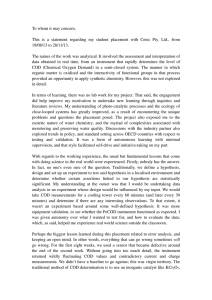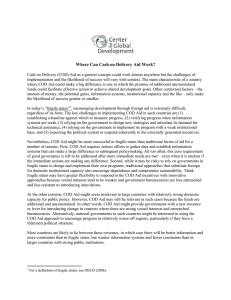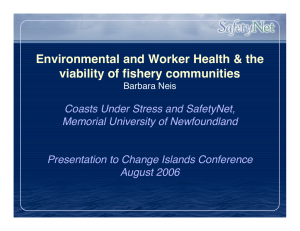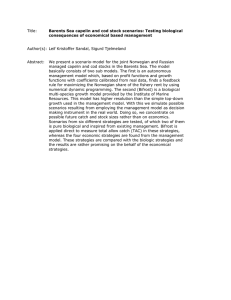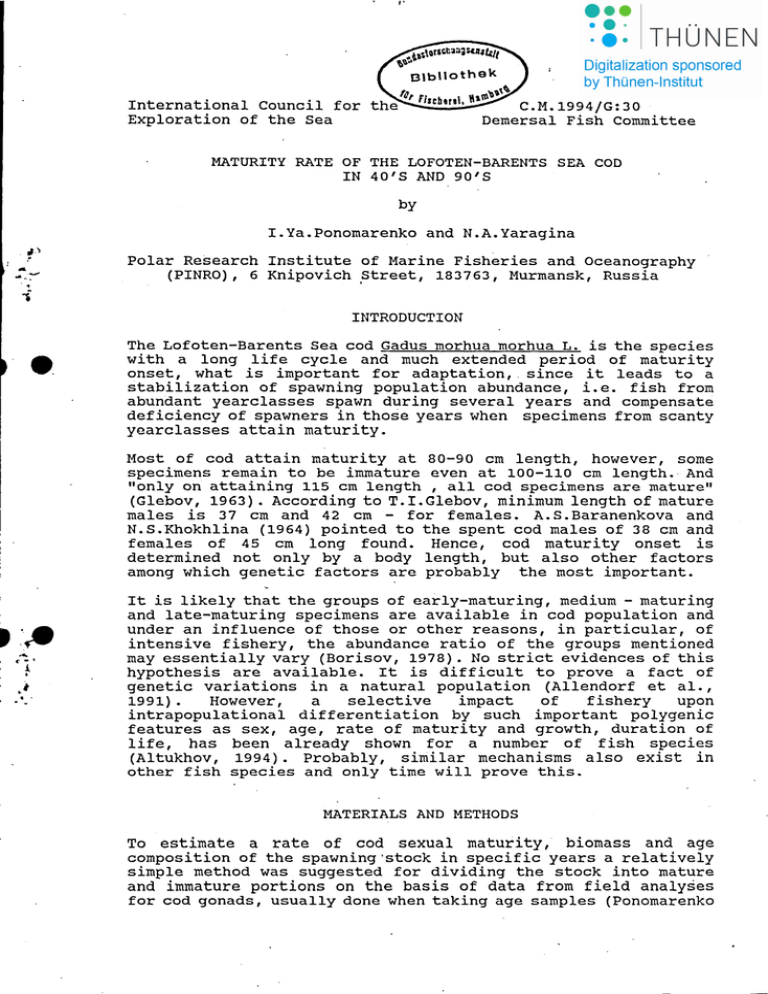
"
International Council for
Exploration of the Sea
C.M.1994/G:30
Demersal Fish Committee
MATURITY RATE OF THE LOFOTEN-BARENTS SEA COD
IN 40'S AND 90'S
by
I.Ya.Ponomarenko and N.A.Yaragina
....
Polar Research Institute of Marine Fisheries and Oceanography
(PINRO), 6 Knipovich ptreet, 183763, Murmansk, Russia
i
INTRODUCTION
e.
The Lofoten-Barents Sea cod Gadus morhua morhua L. is the species
with a long life cycle and much extended period of maturity
onset, what is important for adaptation, since it leads to a
stabilization of spawning population abundance, i.e. fish from
abundant yearclasses spawn during several years and compensate
deficiency of spawners in those years when specimens from scanty
yearclasses attain maturity.
Most of cod attain maturity at 80-90 cm length, however, some
specimens remain to be immature even at 100-110 cm length. And
"onlyon attaining 115 cm length , all cod specimens are mature"
(Glebov, 1963). According to T.I.Glebov, minimum length of mature
males is 37 cm and 42 cm - for females. A.S.Baranenkova and
N.S.Khokhlina (1964) pointed to the spent cod males of 38 cm and
females of 45 cm long found. Hence, cod maturity onset is
determined not only by a body length, but also other factors
among which genetic factors are probably the most important.
t.·.~
...
.
.t
.
c - •
i
.
It is likely that the groups of early-maturing, medium - maturing
and late-maturing specimens are available in cod population and
under an influence of those or other reasons, in particular, of
intensive fishery, the abundance ratio of the groups mentioned
may essentially vary (Borisov, 1978). No strict evidences of this
hypothesis are available. It is difficult to prove a fact of
genetic variations in a natural population (Allendorf et al.,
1991) •
However,
a
selective
impact
of
fishery
upon
intrapopulational differentiation by such important polygenic
features as sex, age, rate of maturity and growth, duration of
life, has been already shown for a number of fish species
(Altukhov, 1994). Probably, similar mechanisms also exist in
other fish species and only time will prove this.
MATERIALS AND METHODS
Ta estimate a rate of cod sexual maturity, biomass and age
composition of the spawning'stock in specific years a relatively
simple method was suggested for dividing the stock into mature
and immature portions on the basis of data from field analyses
for cod gonads, usually done when taking age samples (Ponomarenko
2
et al., 1980). Data were retrieved by separate age and length
groups, by males and females for each of the three areas, .i.e.
the southern Barents Sea (Subarea I) ,
Bear Island - spitsbergen
area (Div.llb) and northwestern coast of Norway (Div.lla). As a
result of the retrieval the number and percent of mature fish
were determined in each age and length group from cod analyzed
during autumn-winter migration to wintering and spawning grounds
(November-February). Gonads of the firstand repetitive
maturing cod differ most clearly from those of immature specimens
during the months mentioned. Besides, as indicated by T.I.Glebov
(1963) in his paper, the occurrence of mature cod in the Barents
Sea is the highest in December-February.
Under field conditions maturity of cod gonads were visually
staged by 6-point scale developed by B.P.Sorokin (1957, 1960).
When retrieving the data fish with gonads at maturity stage land
II in November-February were considered to be immature and mature
- at maturity stages from II-III to VI-lI. While cod belongs to
a group of fish with a prolonged mUlty-intermittent
type of egg
extrusion, " astart of vacuolization phase during a heavy growth
of ovocytes takes place probably simultaneously in all ovocytes
subjected to extrusion in the next spawning season" (Sorokin,
1957). Hence, one can.assume that cod, which did not attain the
gonads maturity stage- III in November-December, were not mature
and would not participate in spring spawning. T.I.Glebov (1963),
as weIl as G.Rollefsen and E.Sivertsen (Glebov, 1963), pointedto
the annual spawning of cod attained maturity. However, some
pUblications have become available in recent years, in which a
possible miss of spawning is stated (Oganesyan, 1993). This can
be confirmed by the analysis·for spawning zones on otoliths.
I
j
.1-
---...
'
RESULTS
The first results from the analysis done by the method given
above pertained to 1966/1967-1977/1978 (Ponomarenko et al., 1980;
Ponomarenko et al., 1985), then the data for earlier and later
years (Ponomarenko , Yaragina, 1981; I.Ponomarenko, 1982;
Ponornarenko, 1984; Lebed, Ponomarenko, 1985, 1986; Yaragina,
1988) were added and the materials for 1946-1990 were analyzed
and given in Fig.1. The method suggested allowed to perform a
retrospective analysis for a rate of sexual maturity of cod males
and females within several decades and to reveal the main trends
of the variations occurred.
Validity of the data obtained by this·rnethod on the relationship
between mature and immature specimens in cod separate age groups
was tested by comparing the calculated and actual (observed) age
composition of "skrei"
on the Lofoten spawning grounds
(Ponomarenko et al., 1980; Ponomarenko, 1984; Jakobsen, 1978,
1979). A well pronounced agreement between the calculated and
actual composition indicates a sufficient reliability of. the
method widely used for annual assessment of the spawning stock of
cod and other fish at present (Anon., 1991, 1992), as well as
when calculating the spawning stock total fecundity (Serebryakov
et al., 1984; Ponomarenko, 1984; I.Ponomarenko, 1982).
Historical data from field analyses for gonad maturity stages
confirroed a concept of extended period of the beginning of cod
.~
.-.
..
. ;..
~
.
:
.". ,;'
:
.
~.
·3
•
t •
sexual maturity (Maslov, 1944; Rollefsen, 1954; Mankevieh, 1964;
Glebov, 1963; Garrod, 1967; Ponomarenko, 1968). A portion of
speeimens (below 1%) of less than 50 em long attains maturity at
age 3-4, whereas the others beeome mature only by 12-14 yr and in
the rarest eases - by age 16.
The main bulk of eod attains
maturity by 8-10 yr at 80-90 em length and 4.0-5.5 kg weight.
Nevertheless, eod at age 7 and even 6 are sometimes predominant
in the spawning stock, if it is presentedby rich yearclasses,
the abundanee of which is mueh higher than the amount of fish at
age 8 and older. Such situation was for example observed in 1976
(Jakobsen, 1978), although in total only 4.5% of mature speeimens
were among 6-year-olds from the very rieh 1970 yearclass •
In 40-80's eod mature speqimens at age 6-9 predominating made up
12% of the total amount of fish analyzed from the whole area
surveyed, with the specimens at age 8-10 being prevalent in 50's,
at age7-8 - in 60's, at age 8-9 - in 70's and at agci 6-7 - in
80's (Fig.1).
The highest amount of mature speeimens was
registered at the northwestern eoast of Norway (59.5%) and much
lesser - in the fattenning areas, in the southern Barents Sea
(5.3%) and in the Bear Island
spitsbergen area (9.9%)
(Ponomarenko, 1984).
Relationship between the rate of sexual maturity and growth is
shown in the paper by V.P.Ponomarenko and co-authors (1985). In
the second half of 60's and in 70's the higher growth rate of eod
was observed in 1967, in 1971-1972, with the lowest being in 1969
and in 1974-1975. In the years of a high growth rate a pereent of
mature specimens from all age groups was somewhat higher than the
mean values and was by
45-35% higher (among 6-9 year-olds)
compared to the years of low growth rate. Therefore, the earlier
maturity of cod in 60's and 70's, compared to 30's and 40's
(Rollefseni 1954; Garrod, 1967), was largely related to an
inerease in its growth rate, sinee the relative number (%) of
mature fish from the length groups studied. did not endure
essential variations, espeeially in fish below 80 cm long
(Fig.3).
Most authors (Maslov, 1944; Rollefsen, 1954; Glebov, 1963;
Ponomarenko, 1968; Konstantinov, Nevinsky, 1969; Ponomarenko et
al., 1980) noted the earlier maturity of males against females.
Analysis for the historical data of 50's - 80's indicate the
percent of mature speeimens from the younger age groups
(3-5 yr) to be approximately similar arnong males and females.
However, by 6 years the maturity rate of males has already been
markedly higher than that of females. Discrepancies in the
pereent of mature males and females inerease and then begin to
decrease by age 9, as far as all males and females attain
maturity by 13-14 yr. As a result of asynehronous maturation of
males and females, among mature cod at age below 10 (Table 1) and
in the length groups below 90-95 the males are preponderant and
females - among the larger specimens (Ponomarenko, Yaraginai in
press). Adult age groups (17-22 yr) are mainly represented by
females, however, very few fish at this age oecur in samples.
Among the cod at age below 9 analyzed (mature and immature) the
sex ratio is close to 1:1 with a minor predominanee of males,but
females prevailing in' older age (Ponomarenko et al., 1985).
4
I
I
Duration of
females.
life
in males
is probably shorter than that, in
DISCUSSIONS
Raise in sexual maturity rate of cod is weIl pronounced by the
data from a number of authors presented the maturity ogives for
different periods of years (Rollefsen, 1954; Glebov, 1963;
Garrod, 1967; Ponomarenko, 1968; Hylen, Dragesund, 1973; Hylen,
Rorvik, 1983; PonOmarenko et al., 1980; Jorgensen, 1990). The
methods used tO calculate the ogives are different, therefore
sometimes it is impossible to estimate a rate of changes.
Comparison of the data obtained by the same method
for 50's,
60's and 70's
showed no essential variations relative tothe
number of mature fish by length and age ~roups studied. At ,the
same time it should be noted that a wide range of fluctuations in
these parameters is observed in separate years and yearclasses.
Such fluctuations not always result from distinctions in cod
growth rate and their reasons are not
completely evident
yet (Ponomarenko, 1984).
When considering the data on males and females separately a
noticeable increase in males maturity rate is observed in 70's,
whereas no increase was registered in that of females, i.e. a
percent of mature specimens from the most groups did not change,
even reduced a little.
These observations somewhat differ from T.Jorgensen's (Jorgensen,
1990) data, according to which the distinctions in each sex
maturity rate in the period of observations over the 1923-1976
yearclasses became smaller. Probably, it was due to the fact that
only the materials from the Lofoten fishery have been used and
cod also spawn to the north and south of the Lofoten, with the
younger age groups spawning northwardly (Lebed et al., 1983) .. In
80's the most amount of spawners was recorded on the spawning
grounds between the Lofoten and Soroy ·(Sundby, Bratland, 1986;
Mukhina, Yaragina, 1988). Hence, the younger age groups with
males prevailing are presented to a small extent in Jorgensen's
analysis.
Thus, as to a raise in maturity rate, a sexual dimorphism in cod
has been found, i.e. females occurred to be more consistent
compared.to males (Ponomarenko, 1984). According to a conclusion
on the sexual dimorphism formulatedöy V.A.Geodakyan (1982),'if
. more pronounced .
any.feature 1S
1n males then the'
same feature
will grow in a whole population. Actually, in 80's a considerable
increase in sexual maturity rate took place in a whole population
and it was continuing early in 90's.
I
I
Rise in maturati on of cod may be accounted for by a considerable
inerease in its growth rate in the first half of 80's, but
probably not only for this, sinee a pereent of mature specimens
has grown much among the cod of the same length in 80's (Fig.3).
A proportion of mature speeimens has mainly grown in eod of 65-80
em long, with a portion of mature males increasing most of all'in
fish at 60-70 cm and females at 70-80 cm length when.considering
sex separately (Fig.4).
.
-.
.
•
•
5
In 80's cod length-groups maturity ogive exposed a leftward and
upward shift~.. which may ba a result of a selective f ishery
decreasing thc abundance'of late maturing fish and increasing a
portion of early maturing ones becausa the latter have more
chances to spawn (Borisov, 1978).An extremely high importance of
shrimp (Pandalus borealis) in cod diet (Ponomarenko, Yaragina,
1984; Ponomarenko, Yaragina, 1990; Yaragina, 1986) - high-calorie
protein food rich with vitamins and microelements - could also
contribute to more rapid growth and maturation. However,
complementary studies are necessary for this suggestion.
-.
•
..
In 80' s . 50% of cod maturation have approached age 7 (7-8 yr
interval) , whereas in 50' sand 70' s 50% of cod attained maturity
at age 8-9 and at age 19-11 - in 40's (Fig.2) ~ A retarded
maturity rate of cod in 40's was probably related to shortening
of fishery in the War time, reduction in fish growth rate and
accumulation of late maturing specimens grouping in spawning
population. According to Jorgensen's (Jorgensen, 1990) data the
mean age of maturity (A w) reduced from 10.5 to 8 yr in tha 19231976 yearclasses, i.e. by 2.5 yr.
~
In the second half of 70's the maturity rate in males has grown,
i.e. 50%-point of maturation was observed in 7-8 yr
interval, whereas 50% of females attained maturity at age about
9, as in 50's and 60's. In 80's 50% of males at age 6-7 and
females at age 7-8 attained maturity. From 50's-70's to 80's the
50%-point of maturation of females has shifted to younger age by
1 year and by 2 years - that of males, which resulted in
essential rise in difference between the number of males and
females mature from the age groups studied, especially among fish
at age 6-7-8 (Fig~5). From 40's to 80's a gradual increase in a
portion of males from spawning population may be a result of,
firstly; a rise in maturity rate, compared to females, and'
secondly, a decline in abundance of older groups among which
females are predominant.
According to D.F.Zamakhaev (1959) year-to-year fluctuations,in
sex ratio in spawning population is a natural phenomenon also
available in virgin populations under asynchronous maturation of
males and females and essential fluctuations in abundance.of
yearclasses. However, prevalence of males and ~eduction in a
portion of females from spawning population matched with a
decline in spawning stock and its early maturation.
Age frequency of older mature cod from the samplas for 80's much
reduced, no fish at age above 10 ware nearly found in it. If in
cod age sampies collected in 40'S fish at age 10 and older made
up on the average 59.6% and 35% in 50's, then in 80's it
constituted only 4.1%. Approximately the same variation was
observed in absolute abundance of cod older than 9 estirnated by
VPA rnethod (Anon., 1993) (Fig.6). Higher maturity rate and early
maturation of spawning stock may be considered as a cod
population "reaction" to the sharply reduced abundance and
biomass. The lattar decreased from 3 mill.t in 1960-1969 to 1
rnill.t in 1980-1989, what was due to an extremaly high fishing
mortality of fish at age 5-10 in 80's , as weIl aso to a minor
recruitment to stock in the sacond half of 70's and in 80's. 10
6
cod yearclasses of 15 which appeared in 1975-1989 occurred tO,be
poor (below 300 mill.individ. at age 3) and 3 to be lower·than
mean abundant. It should be noted that 8 of 10 poor yearclasses
have been scanty already at the stage of eggs (Mukhina, 1992)
what was probably due to higher deficiency of older fish having
a higer indiv~dual fecundity and producing
eggs with a large
supply of nutritive substances compared to first spawning
individuals. A portion of recruits marked~y increased from 1932
to 1987. In 1932-1955 about half of spec,mens caught by a long
line when fishing at the Lofoten
were recruits, their portion increased to 90% by the end of 60's.
In 60's - 80's mean percent of the first spawning individuals
constituted about 80% , essentially varying from year to year
(Jorgensen, 1990).
~
•
:.
CONCLUSIONS
Under a high abundance of cod spawners the yearly fluctuations of
their number probably do not influence markedly the yearclasses
strength. However, a probability of such effect arises and grows
while reducing a spawning fund level (I.Ponomarenko, 1984;
MUkhina, Yaragina, 1988).
While intensificating a 'fishery and growing of cod fishing
mortality from 40's to 80's a steady'reduction took place in its
spawning stock, as weIl as sharp decrease in abundance of older
fish, increase of maturity rate, early maturati~n of spawning
population, drop in a portion of females in it, decline. in
recruitment abundance, stocks and catches of cod.
with due consideration of important and determinative role of
environmental factors and, in particular, temperature conditions
in a formation of each distinct yearclass abundance, it should be
admitted that the total level of reproduction is estimated by the
parental stock size and quality. Hence, in order to change a
long-term trend of reduction in cod stock i t is necessary to
regulate a fishery so as to decrese a fishing mortality to
optimum which will allow to maintain a sufficient amount of older
spawners.
e., •
.
..
R E F E REN CES
ALLENDORF, F.U., RIMAN, N., ATTER, F.M. 1991. Genetics and
management of fish industry. In: Populational genetics
and management of fish industry. AGROPROMIZDAT,
Moscow, pp.15-36 (in Russian).
ALTUKHOV, YU.P. 1994. Genetic consequencies of selective
fishery. In: Genetics.30(1}:5-21 (jn Russian) .
. ANON., 1983. Report of the Arctic Fisheries Working Group.
lCES C.M./Assess:2, 62 p.
o..
. ,
.
7
;
ANON., 1991. Report of the Arctic Fisheries Working Group.
ICES C.M./Assess:3, 127 p.
ANON., 1992. Report of the Arctic Fisheries Working Group.
ICES C.M./Assess:2, 119 p.
ANON., 1993. Report of the Arctic Fisheries Working Group.
ICES C.M./Assess:1, 169 p.
BARANENKOVA, A.S., KHOKHLINA, N.S. 1964. Size of mature cod
from the Arcto-Norwegian stock in 1959, 1960, 1961.
In: Materials of fisheries investigations in the
Northern basin.I~:9-12 (in Russian) .
BORISOV, V.M. 1978 .. Selective impact of fish with a long cycle
on populational structure.ln: Voprosy ikhtiologii.
vol.18, 6(113):1010-1019 (in Russian).
GARROD, D.J. 1967. Population dynamics of the Arcto-Norwegian
cod.//Journal of the Fisheries research board of
Canada.Vol.24, No.1, pp.145-190.
,
GEODAKYAN, B.A. 1982. Sexual dimorphism and evolution of
duration of" ontogeny and its stages.// Reports of the
USSR Academy of Sciencies, 263(6) :1475-1480 (in
Russian).
"GLEBOV, T.I. 1963. Cod of the Murman coast.//
15:69-130 (in Russian).
HYLEN,
~.
...
Tru~y
PINRO,
A~,
DRAGESUND, O. 1973. Recruitment of young ArctoNorwegian cod and haddock in relation to parent stock
size.//Rapp.p.-v.Reun.Cons.int.Explor.Mer. Vol.164,
p. 57-68.
HYLEN, A., RORVIK, C.J. 1983. Estimating the maturity ogive for
Northeast Arctic cod by a modified mesh assessment
model.//Reproduction and recruitment of Arctic cod.
Proceedings of the Soviet-Norwegian symposium, 26-30
September 1983. Ed.by O.R.Godo and S.Tilseth.
Institute of Marine Research, Bergen, Norway. P.153186 •
JAKOBSEN, T. 1978. Skreiinnsiget i Lofoten i 1976.//Fisken Hav.
N.1, 1-8 pp.
JAKOBSEN, T. 1979. Skreiinnsiget i Lofoten i 1978.// Fisken
Hav. N.2, 19-28 pp.
JORGENSEN, T. 1990. Long-term changes in age at sexual maturity"
of Northeast Arctic cod (Gadus morhua L.)//
J.Cons.int.Explor.Mer, No.46, 235~248 pp.
KONSTANTINOV, K.G., NEVINSKY, M.M. 1969. ~ex ratio of Atlantic
cod.// Voprosy ihktiologii. Vol.9, 4(57} :758-759
(in Russian) •
.
·1
I
8
LEBED, N.A., PONOMARENKO, l.Ya., YARAGlNA, N.A. 1983. Some
results of cod tagging in the Barents Sea in 19661982.//lCES C.M. 1983/G:21, 21 p.
LEBED, N.A.PONOMARENKO, I.Ya. 1985. Distribution, length-age
composition and rates of maturity in different length
and age groups of the Lofoten-Barents Sea cod in
1982.//Annl.Biol. Vol.39, pp.92-95.
LEBED, N.A., PONOMARENKO, I.Ya. 1986. Distribution, length and
weight-at-age composition and proportion of mature
fish in differeny age groups of the Lofoten-Barents '
Sea cod in 1983.// Annl.Biol. Vol.40, pp.91-93.
MANKEVICH, E.M~ 1964. Age composition of cod in the Barents Sea
in 1963.//Materials of PINRO scientific Council
session by results from the investigations for 19621963. Murmansk, pp.112-117 (in Russian).
MASLOV, N.A .. 1944. Bottom fishes of the Barents Sea and their
fishery.// Trudy PINRO, 8:3-186 (ln Russian) ..
'..
.4
MUKHINA, N.V. 1992. Results from ichthyoplankton surveys
conducted in the Norwegian and Barents Seas in 19591990.// Ecological problems of the'Barents Sea.
'
-Trudy PlNRO, Murmansk, pp.62-102 (in Russian).
MUKHINA, N.V., YARAGINA, N.A. 1988. Some aspects of dynamics of
the Lofoten-Barents Sea cod recruitment in relation to
a parental stock size.// Biology of fishes in the
European North seas. Murmansk, pp.15-25 (in Russian)'.
OGANESYAN, S.A. 1993. On periodicity of the barents Sea cod
reproduction.// Materials of PINRO report session by
results from research for 1992. Murmansk, pp.76-89
(in Russian) •
PONOMARENKO, V.P. 1968. On effect of fishery upon growth rate
and maturation of cod of the Barents Sea.// Materials
of fisheries investigations of the Northern basin.
Murmansk, 11:39-50 (in Russian).
PONOMARENKO, V.P., PONOMARENKO, l.Ya., YARAGINA, N.A. 1980.
Growth and maturation of the Lofoten-Barents Sea
cod.// lCES C.M./G:25, 28 p.'
PONOMARENKO, I.Ya., YARAGlNA, N.A. 1981. Relation between
mature and immature specimens among cod of different'
age and size in 1978-1980.// lCES C.M./G:22, 11 p.
'
PONOMARENKO, l.Ya~ 1982. Portion of mature cod specimens and
sex ratio at different age and size groups within the
1960's to 1980's.11 ICES c.M./G:18, 11 p.
PONOMARENKO, I.Ya., YARAGINA, N.A. 1984. Seasonal, local and
year-to-year variations in the feeding of the Barents
Sea cod on shrimp.//lCES C.M./G:7, 20 p.
...
.;
PONOMARENKO, I.Ya. 1984. Portion of mature specimens
ratio in different age and length groups of
Lofoten-Barents Sea cod in 60's and 70's.11
of the Northern basin biological resources
commercial exploitation. Murmansk, pp.70-84
Russian) .
and sex
the
Ecology
and their
(in
PONOMARENKO, V.P., PONOMARENKO, I.Ya., Yaragina, N.A. 1985.
Variations in the Barents Sea cod growth and sexual
maturity. In: Theory of formation of abundance and
rational exploitation of commercial fish stocks.
Nauka~ Press, Moscow, pp. 73-82 (in Russian) •
PONOMARENKO, I.Ya., YARAG+NA, N.A. 1990. On year-to-year
interrelations between cod (Gadus morhua morhua L.)
and shrimp (Pandalus borealis Kroyer)in the Barents
Sea. In: Biological resources of the shelf and
marginal seas~ Nauka Press, Moscow, pp. 206-215
(in Russian) •
PONOMARENKO, I.Ya.,·YARAGINA, N.A. Sexual maturity rate of the
Lofoten-Barents Sea cod in 40's - 89's. In: Voprosy
ikhtyologii (in press) .
ROLLEFSEN, G.. ~954. Observations on the cod and cod fisheries
of Lofoten.11 RaPPI et proces-verbaux reunions.
Vol.136. P.40-47.
SEREBRYAKOV, V.P., BORISOV, V.M., ALDONOV, V.K. 1984.
Populational fecundity and strength of the ArctoNorwegian cod yearclasses.11 Reproduction and
recruitment of cod. Proceedings of the 1st SovietNorwegian Symposium. VNIRO, Moscow, pp. 94-124
(in Russian).
.ce
SOROKIN, V.P. 1957. Ovogenesis and sexual cycle in cod
(Gadus morhua morhua L.). Trudy PINRO, 10:125-144
(in Russian). .
SOROKIN, V.P.1960. Sexual cycle and spermatogenesis in cod.
Trudy PINRO, 12:71-87 (in Russian) •.
SUNDBY, S., BRATLAND, P. 1986. Kartlegging av gytefeltene for
Norsk-Arktisk torsk i Nord-Norge og beregning av egg
produksjonen i arene 1983-1985./Fisken Havet (I), 1987
pp. 1-58.
YARAGINA, N.A. 1986. Food composition, stomach fullness and fat
content of cod in the Barents Seain 1983.1/ Annal.
Biol.Vol.40, pp.96-97.
YARAGINA, N.A. 1988. Dynamics of sexual maturation of the
Lofoten-Barents Sea cod in 1985-1987.//
ICES C.M~/ G:34, 6 p.
t
ZAMAKHAEV, D.F'.' 1959. On types of length/sex ratio in fish./I
Trudy MOSRYBVTUZA, 10:183-209 (in Russian).
Tablc 1.
Rutio of males and fcmales from different nge groups of mature cod in
50'0 - gOIs in thc Barcnto Sea and adjncent waters (I.,..IIB+IIA)
AGE
50's
.
1st half:2nd half .:1st
.
.•
80's
70's
60's
..
half : 2nd hulf :1st half
.
..
:2nd half
1990~91-
1992 93
4+(5)
1,31
1,46
0,94
3,80
1,05
3,67
·7,32
2,73
5+(6)
1,33
1,69
1,06
3,58
2,14
2,69
2,82
2,14
6+(?)
1,12
1,49
1,90
1,60
2,08
1,92
1,31
1,15
7+(8)
1,09
1,66
1,43
2,64
1,83
1,38
1,00
1,01
8+(9)
1,26
1,36
1,21
1,26
1,59
O,ffl
0,68
0,82
9+(10)
°,f!7
1,06
1,09
0,74
1,04
0,58
0,50
0,59
10+(11)
0,?9
0,77
0,70
0,51
1,00
0,43
0,53
0,51
11+(12)
0,72
0,65
1,29
0,27
1,00
0,32
0,12
0,19
12+(13)
0,12
0,60
0
0,57
0,50
0,18
0,14
0,40
13+(14)
0,86
0,57
0,33
0,60
Total
1,27
1,24
1,33
°
0,25
1,02
°
0,20
1,74
1,79
1,91
1,01
H
o
"
-
'-"
.
Table 2.
AGE
2+(3)
3+(4)
1958259-:196°2611959 60 :1964 65
f1.
:1965/66:1969/70
71
197°2
1974 75-
19'/5/76-
19'/7/00
1980/811984/85
1985/861989/90
0,9
0,5
0,2
1,6
1,4
6,5
2,4
5,8
19,8
43,8
25,8
:I990zj9I:199 93
0,3
0,8
0,1
0,5
1,5
5,8
3,2
4,8
1,3
3,6
1,2
6,8
11,2
21,1'
19,9
10,7
4$,4
'70,7
27,4
47,9
16,0
30,5
20,5
49,0
45, I
64,4
68,7
79,0
86,7
91,7
96,8
58,2
75,4
62,4
82,7
73,2
95,4
93,3
95,3
99,6
76,9
98,4
100
98,5
99,3
76,2
89,7
90,5
82,8
100
100
95,0
100
100
100
100
raa
raa
93,2
100
100
100
100
100
100
100
100
100
100
100
100
100
100
43,4
8+(9)
66,1
83,1
13+(14)
14+(15)
.
°
0,4
7+(8)
11+(12)
12+( 13)
e
,..,
°
0,5
°
1,1
4,2
10,6
19,9
10+(11)
"
Percent of mature fish runong cod at different age during migration
to wintering and spawning gro~~ds in lGES areas I, lla and lIb.
4+(5)
5+(6)
6+(7)
9+(10)
..
•
e
88,1
84,4
100
66,2
86,1
68,2
100
...
100
30 '-'
12
... ,/, ,
\
20
I
40
,
\
\
\
,
\
10
't'tOf
845
,
\
\ \.---
2
3
4
5
6
7
8
9
10 11
spee.
12
--
13 14+
(and older)
30
50
20
-_ ~ .... .-- ---'....
10
8748
1091
........
,,
,.....
.....
.....
,
_--
et
30
60
,..-",,"
,,
20
59590
,,
'1,.836
,,
10
,
'--
- ...
......
30
r-
I
20
."\
"
I
10
70·
\
I
\
\\
50187
4759
\
'.
\
"
'- ... ..... (J{
/0
, -""\ \
30
\
//
/
,,
20
/
-,
10
Cf) . -
\
\
40372
\
\
\
\
I
\
I
\
I
I
_J
2.
Fig.1.
.3
4
8743
\
5
6 7
Age
8
.... .....
....
--
S 10 11
12 13 14'
(and older)
Age eOffi,position of ~'nelysed (solid line) and mature
(dotted) eod in [-1-0 t s - 80 I s. IJumbers of analysed and
mature fish are given in figures (lower)
I3
%
100
T+-118 +-Da
- -
90
80
70
60
•
+
/
40
·1
/'
,
+'
/
+/
,,
/
30
,
/
/
20
--5
/.
10
'.
-x-1
-- ---- 2
-~_.- 3
---4
4
5
_ ... -
6'
-_._._----_._-------------_._------ --
Fig.2.
fu~turity
7
8
9
10
11
12
6
13
14 _
ogivesof eod and loeation of 50-point maturaration in 40's - 80's (1-5 according to our data:1-40's,
2 - 50 1 s, 3 - 60 1 s, 4 - 70 1 s, 5 - 80 1 s; 6 - 40's - by
Garrod (Garrod, 1967).
14
80 .
60
40
20
'---
50
100
60
-
70
120
-80
%
80
__ 1
---2,
-------- 3
60
40
20
50
Fig.3.
_ 60
70
90
80
Length, cm
-100
110
120
Percent of mature fish among cod at different length
in 30 s - 40's (1) öy GleboV's daia (1963), in 60's'
70 s (2) _ oy Ponomarenkots data (1984) and in 80's '
by our data.
"
15
.r
I~
I
"/.
100 ~
od
80
e·
.,...../ I ""
..
, ••--y
80
~.:':,,::;:::::::
~
.
...
60
.'
,,/ I
60
I
~.I
.,'
/
/j0
•.-
20
..'
..
.....
20
SO
_--.J
60
'10
100 %
so
80
100
~Q
I
iO
GO
/
40
I
I
I
/
/
/
r-
110
.1'2.0
" '"
.
/
,
100 •
70
ao
70
80
90
100
110
...:::.... .,,--
r-
1'2.0
,
....00'7
/
.. I "
60
"
",
/
.
"I
,.'"
..
...
/j0
...
,,'
"
"I
.....
...." ..,.."'" "
I
I
/
I
/
I
.'
"
".'
/
.::.--=.... SO
100
r
--1
Fig.4.
/
,./
" 0 . 120
50
60
Length, Cm.
."
I
80
20
60
I
I
'
20
50
..
I
."
..' /
I
I
,~
....... --",,"
so
I
- - - 2
70
so
90
100
110
----.--. 3
Percent of m~ture fish imons cod males and females.
Sec FiG.3 legend.
120.
16
'100%
;'
50'
...... ...
/
I
,..." ...... -...... .... .../"
I
I
I
I
I
I
,I
50
I
-o'cI'
--- ~~
4
100
7
6
5
8
10 11
9
%
,.- ..
80'
12
13 '14
..---
I
I
I
I
I
I
/
I
./
/
'/
I
/
50
-c1r:f
---~~
e')
.
.
/
-;
I
/
,/
/'
-_-/
4
5
"
6
7
8
9 10 11
12
Age
Fig.5.
Percent of matuI'e specimens amonß cod males and
females in 50's and SOlS
,
4
~
a.>
'd
r-t
o
17
'0
8;
o
'""" 320
f
%
: 300
F(5-10)
\
0,9
........····3······
60 60
'0:
0' .
......
o
. .......
........- ... -
G,?
,
d 40
40
0.5
l1),
-.
~
-
01
~,
~ '20
~I
'"--._._.-...............
20
•
40-"
900
o
Q)
0,3
...... :---.,
50-
00-
70-
50-·
60- ;'
70-:'
80-
1960-1969
1970-1979
1980-1989
'80.- ;
r--
p.,]
CI2
•
rl
r-t
-..-I
..
,Ei
Q)
500
0
§
'0
s:l
~
,300
~;
f-
40-
,e
t.
•
19lj6-1949
1950-1959
Fig.6. Yearclass abundance of cod at age 3 (columns)* in 40's
80's in comparison with abundance of older fish (1 - absolute abundance of cod above 9 yr·*, 2 - its percent in age
sampIes) and with a coefficient of fishing mortality of cod
at age 5-10 yr** (3)
* - by rOES Working Group calculations (Ano~., 1983, 1993)
** - for 60's - 80's - by WG calculations (imon., 1993),
for 40's - 50's - by V.L.Tretyak's calculations



